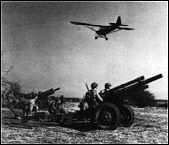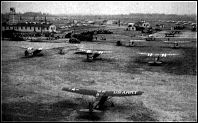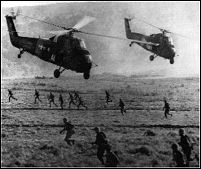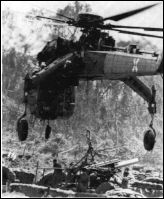History of army aviation
A Proud Past
Army Aviation traces its origins back to the American Civil War. Both Union and Confederate forces used hydrogen-filled balloons to direct artillery fire, marking the beginning of U. S. military aeronautics and aerial support of Army ground forces. The Army also used balloons during the Spanish American War and World War I, but airplanes replaced balloons for most military purposes during the latter conflict.
 Army Aviation began in 1909 with the Army’s acquisition of its first heavier-than-air “flying machine”, an airplane built to Army specifications by the Wright brothers. During World War I, the Army’s aircraft strength grew from a few dozen to more than 11,000 planes and the number of aviation personnel came to total more than 190,000. The Army Air Service was created in May of 1918.
Army Aviation began in 1909 with the Army’s acquisition of its first heavier-than-air “flying machine”, an airplane built to Army specifications by the Wright brothers. During World War I, the Army’s aircraft strength grew from a few dozen to more than 11,000 planes and the number of aviation personnel came to total more than 190,000. The Army Air Service was created in May of 1918.
After World War I, General William Mitchell and other Air Service leaders spoke out forcefully in favor of an independent air force. Since they envisioned aviation as a separate striking force, capable of independent operations, they opposed its remaining an arm of the ground forces.
Although Congress, as well as most Army leaders, rejected Mitchell’s argument, the Air Service did become a separate combat arm, equal in status to the infantry, cavalry, and artillery. In 1926, the name of the air arm was changed to Army Air Corps, and then in June 1941, the Air Corps and other Army air elements were merged to form the Army Air Forces, co-equal with the Army Ground Forces and the Army Service Forces.
During the 1930’s, many Army Air Corps leaders became preoccupied with strategic air operations. Like Billy Mitchell before them, they advocated using air power independently of the Army ground forces to destroy enemy targets behind enemy lines. This Air Corps emphasis on strategic operations disturbed some ground forces leaders who believed their aerial support needs were being neglected.
Aerial support was particularly vital for artillery fire adjustment. Partly because Air Corps fire support aircraft were not always available, the chief of field artillery and other artillery officers became interested in using light aircraft organic to the artillery units.
The Army experimented with using small organic aircraft for artillery fire adjustment and other functions in maneuvers at Camp Beauregard, La. in August 1940. The tests were repeated on a larger scale in the Army maneuvers in Louisiana, Tennessee, Texas, and the Carolinas in 1941. The Army’s “Grasshoppers,” as these light planes came to be called, proved to be much more effective than the larger Air Corps planes used for the same purposes.
Following a final series of experiments with organic Army spotter aircraft conducted in 1942, the Secretary of War ordered the establishment of organic air observation for field artillery (hence the birth of modern Army Aviation) on 6 June 1942. It was this new World War II-era phenomenon with its few small single-engine spotter planes, organic Army Aviation, that eventually evolved into today’s Army Aviation Branch. On the other hand, the organization that had been the Army Air Service and the Army Air Corps continued through World War II as the Army Air Forces and finally became the U. S. Air Force in 1947.
 Organic Army Aviation first entered into combat in November 1942 on the coast of North Africa. During World War II, L-4 Grasshoppers and a few larger L-5 Sentinels were used to adjust artillery fire, gather intelligence, support naval bombardment, direct bombing missions, and perform other functions. Most training of both pilots and mechanics was conducted by the Department of Air Training within the Field Artillery School at Fort Sill, OK, although the Army Air Forces conducted some primary training of organic Army Aviation personnel.
Organic Army Aviation first entered into combat in November 1942 on the coast of North Africa. During World War II, L-4 Grasshoppers and a few larger L-5 Sentinels were used to adjust artillery fire, gather intelligence, support naval bombardment, direct bombing missions, and perform other functions. Most training of both pilots and mechanics was conducted by the Department of Air Training within the Field Artillery School at Fort Sill, OK, although the Army Air Forces conducted some primary training of organic Army Aviation personnel.
The Korean conflict provided new challenges and opportunities for Army Aviation. Organic Army Aviation had acquired its first helicopters, thirteen H-13 Sioux in 1947, shortly before the U. S. Air Force became independent of the Army. In Korea, the Army employed the 0-1 Bird Dog and other improved fixed wing planes, but also helicopters. The Army used its H-13’s primarily for medical evacuation, command and control, and transport of lightweight and valuable cargo. Because of the rugged terrain of the Korean peninsula, the value of helicopters came to be recognized by all the services; the demand for both helicopters and trained aviators consistently exceeded the supply.
 In 1951, the Army began organizing five helicopter transport companies and training warrant officer pilots. There was, however, an ongoing rivalry between the Army and the Air Force concerning responsibility and resources for the aerial support of ground forces. Because of this rivalry and also because of the shortage of helicopters, only two Army transport companies were supplied with H-19 Chickasaw helicopters in time to participate in the Korean conflict. Transport helicopters, nevertheless, proved themselves by moving cargo and personnel during the final months of the war and then by participating in prisoner exchanges and other functions after the cessation of hostilities.
In 1951, the Army began organizing five helicopter transport companies and training warrant officer pilots. There was, however, an ongoing rivalry between the Army and the Air Force concerning responsibility and resources for the aerial support of ground forces. Because of this rivalry and also because of the shortage of helicopters, only two Army transport companies were supplied with H-19 Chickasaw helicopters in time to participate in the Korean conflict. Transport helicopters, nevertheless, proved themselves by moving cargo and personnel during the final months of the war and then by participating in prisoner exchanges and other functions after the cessation of hostilities.
During the Korean conflict, the Department of Air Training at Fort Sill expanded and in early 1953, it became the Army Aviation School. As a result of the expansion of both aviation and artillery training, Fort Sill became overcrowded and the Army decided to move the Army Aviation School to a different post. When no satisfactory permanent Army post was found, a temporary post, Camp Rucker, Ala., was chosen.
The Army Aviation School began moving to Alabama in August 1954 and the first class began at Rucker in September. In March 1955, the Army Aviation Center was established at Rucker and in October of that year, the post was given permanent status with the name change from Camp Rucker to Fort Rucker.
 Prior to the mid-1950s, the Army Air Forces / U. S. Air Force had provided primary training for Army Aviation pilots and mechanics. In 1956, DOD gave the Army control over all of its own training. Gary and Wolters Air Force bases in Texas, where the Air Force had been conducting this training, were also transferred to the Army. Lacking adequate facilities at Fort Rucker, Army Aviation continued primary fixed wing training at Camp Gary until 1959 and primary rotary-wing training at Fort Wolters until 1973.
Prior to the mid-1950s, the Army Air Forces / U. S. Air Force had provided primary training for Army Aviation pilots and mechanics. In 1956, DOD gave the Army control over all of its own training. Gary and Wolters Air Force bases in Texas, where the Air Force had been conducting this training, were also transferred to the Army. Lacking adequate facilities at Fort Rucker, Army Aviation continued primary fixed wing training at Camp Gary until 1959 and primary rotary-wing training at Fort Wolters until 1973.
In 1956, the Army Aviation Center began assembling and testing weapons on helicopters. These tests, conducted while the Air Force still theoretically had exclusive responsibility for aerial fire support, led to the development of armament systems for Army helicopters.
The first armed helicopter company was activated in Okinawa in 1962. It was deployed to Thailand and then to Vietnam, where it flew escort for lift helicopters. The Department of Defense did not abolish mission restrictions on the Army’s rotary-wing aircraft, and thereby technically authorize the Army to arm helicopters until 1966.
The “Howze Board” or “Tactical Mobility Requirements Board” was established in 1962 to develop and test the concept of air mobility. After test exercises, war games and concentrated study and analysis, the Howze Board recommended that the Army commit itself to organic air mobility –later known as air assault.
The Howze Board recommended the extensive use of helicopters to transport infantry troops, artillery and supplies, as well as to provide local aerial fire support. These recommendations were tested by the 1st Air Assault Division (Test) from 1963 to 1965. In 1965, the 1st Cavalry Division (Airmobile) was organized and sent to Vietnam, where it repeatedly demonstrated the validity of the airmobile concept in actual combat.
The most widely used helicopter, the UH-1 Iroquois or Huey, began to arrive in Vietnam in significant numbers in 1964; before the end of the conflict, more than 5,000 of these versatile aircraft were introduced into southeast Asia. They were used for medical evacuation, command and control, and air assault; to transport personnel and material; and as gunships. The AH-1 Cobra arrived in 1967 to partially replace the Huey in its gun ship capacity. Other important helicopters in Vietnam included the CH-47 Chinook, the OH-6 Cayuse, the OH-58 Kiowa, and the CH- 54 Tarhe.
5,000 of these versatile aircraft were introduced into southeast Asia. They were used for medical evacuation, command and control, and air assault; to transport personnel and material; and as gunships. The AH-1 Cobra arrived in 1967 to partially replace the Huey in its gun ship capacity. Other important helicopters in Vietnam included the CH-47 Chinook, the OH-6 Cayuse, the OH-58 Kiowa, and the CH- 54 Tarhe.
Although the concept of airmobility had been developed with a mid-intensity European conflict in mind, Army Aviation and the helicopter had proven themselves during the low intensity conflict in southeast Asia. Afterwards, the Army turned its major attention back to the threat of a mid or high intensity conflict in Europe and doubts reemerged about the value of helicopters in that sort of arena.
Some military leaders believed that the helicopter could not survive and perform an essential role in a heavy combat environment. In order to gain general acceptance and ensure further success, Army Aviation continued to develop new doctrine, tactics, aircraft, equipment and organizational structure. New or radically modified aircraft adopted during the early 1980’s consisted of the AH-64 Apache, the UH-60 Black Hawk, and the OH- 58D version of the Kiowa.
The creation, implementation and consolidation of the Army Aviation Branch dominated the 1980’s. Prominent aviators, as well as other Army leaders had debated the establishment of aviation as a separate branch since the time of the Korean conflict.
The opposition to a separate aviation branch had resulted in part from Army attitudes regarding the Army Air Corps and the U. S. Air Force. In Army circles, both of these aviation organizations were believed to have been unreliable in performing their mission of supporting the ground forces — even after having been given resources to do so. Since Army Aviation had demonstrated its commitment to the support of the ground battle in Vietnam, however, opposition to a separate aviation branch began to wane.
 Also, Army Aviation had grown in size and technological sophistication. This growth caused increasingly complex problems in training, procurement, doctrine development, proponent responsibility and personnel management. Many non-aviators, as well as aviators became convinced that these problems could be solved more effectively by the creation of an aviation branch.
Also, Army Aviation had grown in size and technological sophistication. This growth caused increasingly complex problems in training, procurement, doctrine development, proponent responsibility and personnel management. Many non-aviators, as well as aviators became convinced that these problems could be solved more effectively by the creation of an aviation branch.
Both DA and TRADOC conducted extensive studies of the separate- branch question during the early 1980’s. By 1983, there was a near consensus among Army leaders and the Secretary of the Army signed an order creating the Army Aviation Branch with an effective date of 12 April 1983.
Aviation officer basic and advanced courses were begun at Fort Rucker in 1984 and a gradual consolidation of aviation-related activities followed. In 1986, the U. S. Army ATC Activity became part of the branch; the following year, an NCO academy was established at Fort Rucker. In 1988, the Army Aviation Logistics School, which had been dependent on the Transportation Center at Fort Eustis, was incorporated into the Aviation Branch.
Also in 1988, the Army Aviation Modernization Plan was given final approval and implemented. The modernization plan called for a gradual reduction in the number of Army aircraft as older models were replaced by modern ones. Aircraft adopted or planned during the late 1980’s and early 1990’s included the OH-58D Kiowa Warrior, the RAH-66 Comanche, and a new training helicopter.
Army Aviation’s role of providing the indispensable vertical dimension to the modern battlefield has come to be universally recognized. For example, during operations in Grenada, Panama and the Persian Gulf region, Army Aviation played major and decisive roles.
One of the very first blows of Operation Desert Storm was struck by Army Aviation. Apache helicopters destroyed Iraqi early warning sites shortly before allied bombs began exploding over Baghdad. Then, during the 100 hours of ground combat, Army helicopters dominated night-time operations.
The decreased military budgets following the end of the Cold War forced both the Army and Army Aviation to downsize. Army Aviation’s response was to develop the “Aviation Restructure Initiative,” a plan to decrease the size of the force while continuing to meet its mission and also overcoming existing deficiencies. The ARI aims to accomplish these goals through continued modernization of the fleet and reorganization of the force.
The post-Cold War environment provides new opportunities for Army Aviation to serve our country. Aviation is uniquely qualified for infiltration, reconnaissance, evacuation and strike missions of unconventional warfare. Because of its unique combination of versatility, deploy-ability and lethality, Army Aviation is assuming additional missions and functions in the rapidly changing world of the new millennium.
